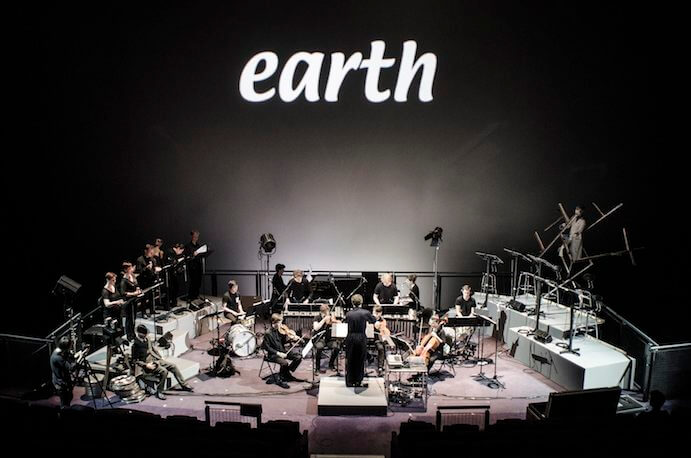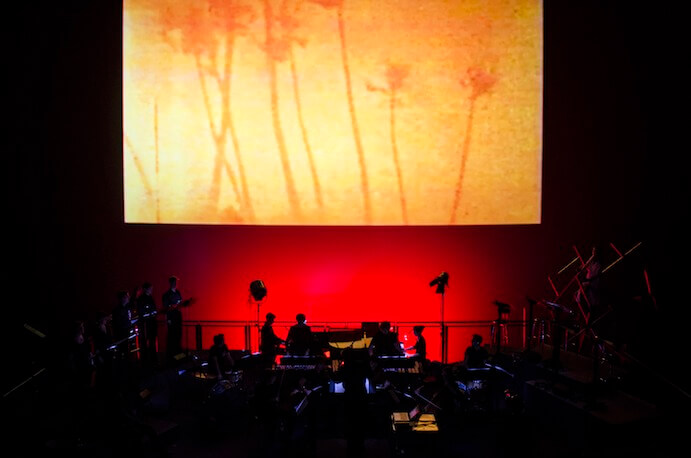Steve Reich wrote his rarely performed Three Tales between 1998 and 2002, and each concerns a key event in 20th-century history: the crash of the Hindenburg zeppelin in 1937 (Act I), the nuclear bomb testings at the Bikini Atoll in 1946-58 (Act II), and the cloning of Dolly the Sheep in 1996 (Act III). The music is accompanied by a video by Beryl Korot (Reich’s wife). Ensemble BPM has a special relationship with this piece: they gave the first production after its premiere run, and also performed the piece at the Tête à Tête Opera Festival in 2010. This familiarity bore itself out in a solid performance on 22 April 2015 that felt confident and exciting in the unique and fitting venue of London’s Science Museum IMAX Theatre. The piece required a huge array of collaborators to pull off successfully including Synergy Vocals, the Ligeti Quartet, conductor (and Ensemble BPM founder) Nick Sutcliffe, director Matthew Eberhardt, stage designer Gillean Denny, lighting designer Stuart Webb, and producer Amanda Carrick. Special mention must be made for Sound Intermedia who did a brilliant job of navigating a rather unforgiving space and setup for the music.
It was a unique setting– the programme claimed this was the “first-ever staging of an opera in an IMAX theater.” In 2015, there exists a desire to say literally anything can be considered an opera, but it is a little hard to understand this categorisation. Some would argue that the distinctions are pedantic, but calling something an “opera” does create certain expectations of drama (if not narrative) and, in this case, neither the video or music make any sort of attempt at achieving this. Successfully fusing live video with live music is already an extremely difficult tightrope, and perhaps Reich’s labeling of the piece a “documentary digital video opera” goes some way toward explaining these dramatic confusions.

Steve Reich’s Three Tales at the London Science Museum
There were amplified voices throughout, but almost always in the shape of a chorus that echoed, foreshadowed, or sang in tandem with the images from Korot’s film. There were some minor elements of staging: a doll on a beach chair, or the choir moving from stage right to stage left between Acts II and III, but this piece so closely fuses image and music that it is really a live performance of a film with a soundtrack. This was particularly true of the very best moments of the score, where metallic percussion and pulsating, staccato strings shaded the video with symbols of industrialisation and technology.
While it is technologically a massive undertaking, Three Tales does feel a bit of a lesser cousin to Reich’s earlier works such as Different Trains and City Life. The first and second act had a sort of middling visual interest which paired awkwardly with music that was so clear in its character. In the second act, the video seemed to reach after tension in the form of an extended countdown toward the explosion of a nuclear device. With an increasing visual tempo, jump-cuts and snippets of text, the video cycled through a countdown from 10, each time returning to a number one-less than had laid out the section before.

Steve Reich’s Three Tales at the London Science Museum
There’s another difficulty for the composer utilizing technology, and that is how quickly even the most cutting edge technology becomes archaic. It’s totally fine, of course, for a film to look as if it was created in the 90s, but where this video would have achieved more tension in 1997, in 2015 the whole audience has already seen a number of these nuclear explosions on YouTube or in class at school. Since Reich’s musical accompaniment to this countdown is also in such a familiar and unbroken idiom, the listener ends up feeling rather like Harrison Birtwistle waiting for a bus.
After all this, the third act was an entertaining and welcome bit of playfulness. Video of Richard Dawkins preaching that “we, and all other animals, are machines” was cut up and spliced together with extracts from Genesis, along with religious scholar Rabbi Adin Steinsaltz. The video was put through the (again, then novel, now familiar) ‘slow-motion sound’ technique, and repeated in a way that removes the meaning from speech and instead emphasizes the musical contour of the voice. This contour then found it’s way into the musical material. The truth is that this is a wild bit of forward innovation. In recent years its appeared in serious theatre such as London Road. Unfortunately, all one could think of in 2015 was hide your kids... and the opening sequence to Unbreakable Kimmy Schmidt.






















